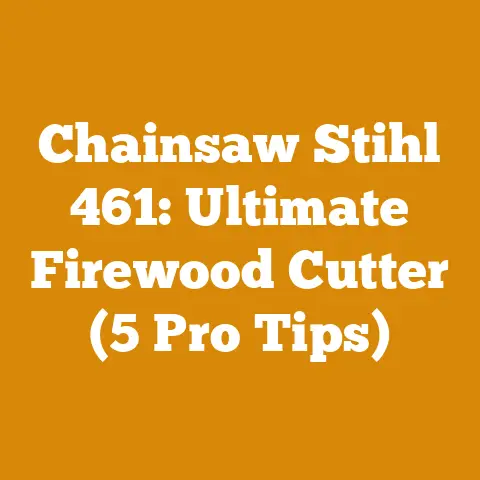How to Calculate a Cord of Firewood (5 Pro Tips for Accurate Measurement)
Did you know that miscalculating a cord of firewood could cost you hundreds of dollars, whether you’re buying or selling? It’s a surprisingly common mistake, and one I’m determined to help you avoid.
How to Calculate a Cord of Firewood (5 Pro Tips for Accurate Measurement)
As someone who’s spent a good chunk of my life wrestling with logs, axes, and the satisfying crackle of a wood-burning stove, I can tell you that accurately measuring firewood is more than just a formality – it’s about getting what you pay for, ensuring fair deals, and, frankly, avoiding potential neighborly disputes.
I remember one particularly frosty winter when I was just starting out. I thought I’d scored a great deal on a “cord” of firewood. Turns out, the stack was more like a generous half-cord. I learned my lesson the hard way – a cold house and a lighter wallet.
So, let’s dive into the nitty-gritty of how to calculate a cord of firewood, packed with pro tips I’ve gathered over the years. Trust me, these insights will save you time, money, and maybe even a few strained muscles.
Understanding the Basics: What Exactly Is a Cord?
The term “cord” gets thrown around a lot, but what does it actually mean? A cord is a precisely defined unit of measurement.
- The Official Definition: A cord is a stacked pile of wood measuring 4 feet high, 4 feet wide, and 8 feet long. This equates to 128 cubic feet.
- Important Note: This measurement includes the air space between the pieces of wood. It’s not 128 cubic feet of solid wood.
Why the Confusion?
The problem arises because firewood is rarely sold in perfectly stacked, uniform pieces. That’s where the potential for miscalculation creeps in.
Pro Tip #1: Visualizing the Cord – The 4x4x8 Rule
The easiest way to understand a cord is to visualize it. Think of it as a rectangular prism, like a giant block of wood.
- Height: 4 feet
- Width: 4 feet
- Length: 8 feet
If you can picture this shape, you’re already halfway there.
Beyond the Full Cord: Face Cords, Rick, and Other Terms
You’ll often hear terms like “face cord” or “rick.” These are not the same as a full cord.
- Face Cord/Rick: A face cord is typically 4 feet high and 8 feet long, but the width (the length of the individual pieces of wood) can vary. A common length is 16 inches, but it could be anything.
- Calculating a Face Cord’s Volume: To determine the volume of a face cord, multiply the height, length, and width (in feet). For example, a face cord that’s 4 feet high, 8 feet long, and 16 inches (1.33 feet) wide would be 4 x 8 x 1.33 = 42.56 cubic feet.
- Converting to a Full Cord: Divide the face cord’s volume by 128 to find out how many face cords equal a full cord. In the example above, 128 / 42.56 = approximately 3 face cords.
Pro Tip #2: Mastering the Measurement – Tools and Techniques
Now, let’s get practical. How do you accurately measure a pile of firewood?
-
Essential Tools:
- Measuring Tape: A good quality measuring tape (at least 25 feet) is essential.
- Level: Use a level to ensure your measurements are accurate, especially when stacking.
- Calculator: For calculating volumes and converting between units.
- Notebook and Pen: To record your measurements and calculations.
-
Step-by-Step Measurement:
- Stacking (If Necessary): If the wood isn’t already stacked, stack it neatly. This is crucial for accurate measurement. Aim for a rectangular shape.
- Measure Height: Measure the height of the stack from the ground to the top. Take multiple measurements and average them to account for unevenness.
- Measure Width: Measure the width of the stack (the length of the individual pieces of wood). Again, take multiple measurements and average them.
- Measure Length: Measure the overall length of the stack.
- Calculate Volume: Multiply the height, width, and length (all in feet) to get the total cubic footage.
- Compare to a Cord: Divide the total cubic footage by 128 to determine how many cords (or fractions of a cord) you have.
Example:
Let’s say you have a stack of firewood that’s:
- Height: 4.2 feet
- Width: 1.5 feet (18-inch pieces)
- Length: 7.8 feet
The volume is 4.2 x 1.5 x 7.8 = 49.14 cubic feet.
To find out how much of a cord this represents, divide by 128: 49.14 / 128 = approximately 0.38 of a cord.
Data Point: Studies show that inaccurate stacking can lead to measurement errors of up to 20%. Taking the time to stack neatly can significantly improve accuracy.
Pro Tip #3: Accounting for Irregularities – The “Fudge Factor”
Firewood isn’t always perfectly uniform. There will be gaps, odd-shaped pieces, and uneven stacks. Here’s how to account for these irregularities:
- The “Eyeball” Method: After measuring the stack, visually estimate the amount of empty space. Reduce your calculated volume by a percentage that reflects the estimated empty space. For example, if you think 10% of the stack is empty space, reduce your calculated volume by 10%.
- The “Re-Stack” Method: If you’re buying firewood, ask the seller if you can re-stack a portion of the wood. This allows you to get a better sense of the actual volume and the amount of empty space.
- The “Loose Load” Adjustment: If you’re buying a “loose load” (firewood dumped in a pile), it’s even more important to be cautious. Ask the seller how they estimate the volume. A reputable seller will be transparent about their methods.
My Personal Experience:
I once bought a load of “seasoned oak” that was delivered as a loose pile. The price seemed too good to be true, and it was. After stacking the wood, I realized I’d been shorted by about 25%. The wood also wasn’t nearly as seasoned as promised. It was a harsh lesson in the importance of careful inspection and dealing with reputable sellers.
Pro Tip #4: Understanding Wood Species and Density
The type of wood you’re buying or selling also affects the perceived value and the actual heat output.
- Hardwoods vs. Softwoods: Hardwoods (like oak, maple, and ash) are denser and burn longer, producing more heat per cord. Softwoods (like pine, fir, and spruce) burn faster and produce less heat.
- Moisture Content: Seasoned firewood (wood that has been dried for at least six months) burns much more efficiently than green wood. Green wood is heavy with moisture, making it harder to light and producing less heat.
- Weight as an Indicator: A cord of seasoned hardwood will weigh significantly more than a cord of seasoned softwood. Weight can be a good indicator of density and moisture content.
Data-Backed Content:
- Heat Output: Oak firewood typically produces around 24 million BTUs (British Thermal Units) per cord, while pine produces around 15 million BTUs per cord.
- Drying Time: Hardwoods generally take longer to season than softwoods. Oak, for example, may take 12-18 months to season properly, while pine may be ready in 6-9 months.
Unique Insight:
I’ve found that mixing hardwoods and softwoods can be a good strategy. Use softwoods to get the fire going quickly, and then add hardwoods for sustained heat.
Pro Tip #5: Negotiating and Ensuring Fair Deals
Buying or selling firewood is a business transaction. Here are some tips for ensuring a fair deal:
- Ask Questions: Don’t be afraid to ask the seller questions about their measurement methods, the type of wood, and the seasoning process.
- Get it in Writing: Always get a written agreement that specifies the quantity of wood, the price, the type of wood, and any guarantees about seasoning.
- Inspect the Wood: Before paying, inspect the wood for signs of rot, insect infestation, or excessive moisture.
- Shop Around: Get quotes from multiple sellers to ensure you’re getting a competitive price.
- Consider Buying in Bulk: If you have the space, buying firewood in bulk (multiple cords) can often save you money.
- Know Your Local Regulations: Some areas have regulations regarding the sale of firewood, including requirements for accurate measurement and disclosure of wood type.
Real-World Case Study:
I recently helped a friend negotiate a firewood purchase. He was quoted a price for a “cord” of mixed hardwood. However, after asking detailed questions, we discovered that the wood was mostly aspen (a relatively soft hardwood) and that the measurement was based on a loose load estimate. By negotiating a lower price and insisting on a stacked measurement, we saved him over $100.
Safety Standards:
- Personal Protective Equipment (PPE): Always wear appropriate PPE when handling firewood, including gloves, eye protection, and sturdy boots.
- Safe Stacking: Stack firewood in a stable manner to prevent it from collapsing.
- Proper Lifting Techniques: Use proper lifting techniques to avoid back injuries. Bend your knees and keep your back straight.
- Chainsaw Safety: If you’re cutting your own firewood, follow all chainsaw safety guidelines. Wear a helmet, eye protection, hearing protection, and chaps.
Challenges Faced by Hobbyists and Small Producers:
- Limited Equipment: Hobbyists and small producers may not have access to the same equipment as large-scale operations. This can make it more challenging to process and measure firewood efficiently.
- Time Constraints: Many hobbyists have limited time to dedicate to firewood preparation. This can lead to rushed work and potential safety hazards.
- Storage Space: Storing firewood properly requires adequate space and protection from the elements.
- Regulatory Compliance: Small producers may struggle to comply with local regulations regarding firewood sales and transportation.
Actionable Takeaways:
- Know the Definition: Understand that a cord is 4x4x8 feet, or 128 cubic feet.
- Measure Accurately: Use a measuring tape, level, and calculator to get precise measurements.
- Account for Irregularities: Adjust your calculations to account for gaps and uneven stacking.
- Understand Wood Types: Know the difference between hardwoods and softwoods, and consider moisture content.
- Negotiate Fairly: Ask questions, get it in writing, and shop around for the best deals.
- Prioritize Safety: Always wear PPE and follow safe handling practices.
Conclusion: The Warmth of Knowledge
Calculating a cord of firewood accurately is a skill that pays dividends. It’s about fairness, value, and ensuring you’re getting the most out of your wood-burning experience. By following these pro tips, you’ll be well-equipped to navigate the world of firewood with confidence, ensuring you get a fair deal and stay warm all winter long. And who knows, maybe you’ll even save yourself from a chilly situation like I did all those years ago. Now go forth and conquer those cords!






